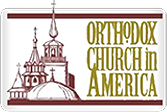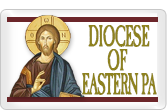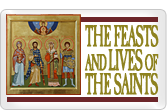Church Etiquette
The Holy Orthodox Church is perhaps one of the last social institutions where dignity, protocol, respect, and reverence are maintained. This is primarily because when we come to the church and its services we are entering the Kingdom of God on earth, His habitation, and we choose to honor this sacred place by our attentiveness to what is proper and ordered. We have the opportunity to reflect the image of Christ within us by our actions.
“You are a chosen generation, a royal priesthood, a holy nation” (1 Peter 2:9)
This guide is meant for personal reflection, not as a means of judging others. Keep in mind that there are different traditions even among the Orthodox faithful. We come to church to pray and worship God above all else, and that should be our only focus.
Entering the Church
The Orthodox Divine Liturgy begins when the priest intones, “Blessed is the Kingdom of the Father, and the Son, and the Holy Spirit.” We need to arrive early enough to receive this blessing. Arriving later and walking around while the Liturgy is going on causes a distraction for others who are praying. If an occasional problem occurs and you have to come in late, enter the church reverently and quietly. The times in which you must stay in the back of the church, or the narthex, before entering include: when the Little or Great Entrance is taking place, when the priest is censing the icons and congregation or giving the homily, and when the Epistle or Gospel is being read. If you are unsure when is the best time to enter the church, ask one of the greeters for guidance. We come to the church on time, as if to a great banquet, and with reverence, because we are partaking of the very Body and Blood of Christ, our Savior. Coming to Orthros or Matins before the Divine Liturgy will ensure that you will be settled in plenty of time to pray without distraction.
Standing vs. Sitting in Church
It is the custom of the Orthodox Christians to stand throughout the services of the Church, whenever the prayers are being offered. It is appropriate to sit down during the sermon or announcements. If, due to your health condition, you have to site down during the service, please try to make an effort to stand at least during these times: when the Liturgy begins and the priest gives the blessing; during the Little and Great Entrances; when there is censing of the icons and congregation; during the Gospel reading; at the Anaphora; for Holy Communion; and at the final Blessing.
Lighting of Candles
It is a pious Orthodox tradition to light candles for personal petitions and intercessions when entering the church. Most parishes have designated candle stands or holders for these candles. It is not proper to light candles at certain times during the service —generally the same times when you should not enter the church, such as during the Little and Great Entrances, when the priest is censing the icons and congregation or giving the homily, or during the reading of the Epistle or Gospel. The candles should be allowed to burn all the way down without being extinguished early, since the burning candle symbolizes our prayers rising to heaven and the light of Christ in our midst. Please do not allow young children to light candles alone, for safety reasons. It is customary to make a donation for each candle.
Venerating Icons
The Orthodox Church teaches that it is proper to venerate, not worship, icons. The acceptable way to do this is to kiss either the hands or feet of the saint depicted in the icon, or the scroll, the Gospel book, or the hand cross a saint is holding, Please do not wear lipstick when kissing the icons since the residue will ruin them.
Preparing and Receiving Communion
In our lives as Orthodox Christians there is no greater gift from God than to receive the Body and Blood of Christ in the Eucharist. This gift should be treasured and by no means partaken of casually, without proper preparation and attention. It is a tradition of the Orthodox Church that in order for us to receive Communion we should be at peace with God and with each other, regularly (at least once a month) have examination of our consciousness in the sacrament of Confession and to make an effort of starting to prepare for this gift by coming to Vespers service on the evening before the Liturgy. It is important to read Pre-Communion prayers either the night before, or in the morning before coming to Church and to observe absolute fast (no food or drink) after you wake up and before you receive the Eucharist. If you have medical condition that requires you to eat something or to take medicine, discussion your circumstances with your parish priest to agree on an acceptable rule of fasting before Communion.
As you approach the Chalice, cross your arms on your chest in the sign of humility. Don’t kiss icons right before or right after you receive and don’t make the sign of the cross near the Chalice.
After you receive Communion, go back to your place in the church. Please remain standing while Communion is being distributed. At this time it is important not to relax but to meditate on Lord’s love towards us and to thank Him for the gifts we have just received. It would be best to read Post-Communion prayers of Thanksgiving (found in most Orthodox Prayer Books) as you wait for the rest of the congregation to receive the Eucharist.
Receiving the Antidoron, Holy Bread
When receiving the antidoron after Holy Communion or after venerating the cross at the end of Divine Liturgy, do not allow the crumbs to drop, since this is blessed bread. Children will need assistance so that they do not take too many pieces, and so they are not careless in handling the bread. After returning to your seat, you may eat the holy bread as you say the prayers after Holy Communion silently while others are communing.
Additional Pious Customs
• Crossing oneself—It is always appropriate to cross oneself at the mention of the Holy Trinity—Father, Son, and Holy Spirit; whenever entering or leaving the church; at the beginning of the Liturgy; when passing in front of the altar; when venerating an icon, the Gospel, or the cross; and at times for personal petitions. It is not necessary to cross oneself when the priest is giving a blessing or censing the congregation. Instead, one should bow to receive the blessing.
• Bowing—Orthodox Christians bow when the Theotokos and Christ are petitioned. They also bow to the priest at his blessing, and when he asks forgiveness before the Great Entrance and again before Holy Communion. It is traditional for the Orthodox faithful to bow and cross themselves when they enter and leave the church, and when they pray before the icons.
• Kneeling—In some Orthodox traditions there are times when kneeling is a pious practice in the Liturgy, the most notable being at the Consecration of the Holy Gifts. However, kneeling is prohibited during the Paschal season (from Pascha to Pentecost) as well as on Sundays, in honor of the Resurrection.
Special Considerations During Liturgy
• Refrain from socializing during the Liturgy. Save your greetings and conversations for the fellowship hall. We are in the Liturgy to greet God with our prayers and worship, not to distract others.
• Cell phones and texting are never allowed in the church. If you have a professional reason to carry a phone for emergencies, keep it on mute and sit near the exit so that leaving for an emergency will not be a distraction to others. Otherwise, turn off your phone before entering the sanctuary.
• Food in the Sanctuary. No food or beverages are allowed to be used inside the sanctuary of the church. If for whatever reason you need to eat or drink something, please step outside for it and then come back. Don’t chew gum during the service, it is not appropriate for the spirit of prayer.
• Refrain from reserving places in the pews. Allow others to sit as they come into the church, and especially make room for visitors so they will feel welcome.
• Lipstick—Do not wear lipstick while taking Holy Communion, or when kissing the cross, an icon, the priest’s or bishop’s hand, or any sacred object. It is best not to wear it at all in the church, because of the damage it causes.
• Leg crossing—One should not be too casual in the Divine Liturgy. People from some cultures are offended by the crossing of legs or by arms thrown back over the pew. Keeping your feet on the ground also enables you to remain attentive and to stand when necessary.
Children in Church
Christ said, “Let the little children come to Me, and do not forbid them; for such is the kingdom of heaven” (Matthew 19:14 ). It is possible for young children to remain in church throughout a service if they are taught to be quiet and respectful. Many parishes have cry rooms or nurseries for those who are too small to be quiet throughout the whole Liturgy.
Please be respectful to those around you if your child becomes fussy or out of control, and remove him from the nave of the church quickly. If a very young child needs a snack, please clear away any leftover pieces. However, the child should not have anything in his mouth when he comes to Holy Communion. It is never appropriate to allow a child to run down the aisles, play loudly, or carry toys that make noise. Eventually, children will be able to spend longer times in the Liturgy. That is where they should be, but remember the reason for coming to church is to pray and worship. Plan to have your children use the restroom and get a drink before church begins, and don’t allow them to come and go continually. Consider bringing your children into the church at a time when the Liturgy is finished to “practice” church behavior. Teach them that they are visiting God’s very special house, and they will need to have very special manners there.
Leaving Church
The respectful protocol is to leave the church only after the final blessing, and after kissing or venerating the cross held by the priest at the end of the Divine Liturgy. It is not acceptable to be in the church hall, kitchen, or an administrative office during Liturgy. Some parishes have church school at the end of the Liturgy. This is the only exception allowed. Those who leave early deprive themselves of a blessing. After walking to the back of the nave of the church, it is customary to face the altar, bow, and make the sign of the cross.
Greeting the Priest and Bishop
In our modern culture, we greet one another with a handshake. The exception to this is when we greet a priest or a bishop. We do not shake a bishop’s or priest’s hand; we ask for a blessing and kiss his hand with reverence, since with this hand he touches the Holy Body of Christ and distributes it to us. The proper way to do this is to approach the hierarch or priest with right hand over left, palms facing up, and then bow while saying, “Master, bless” to the hierarch, or “Father, bless” to the priest. If either places his hand in yours while blessing you, this is an appropriate time to kiss his hand.
Church Clothing
Whenever we are preparing to come to church, we should remember that we will be entering the House of God. This requires that we dress modestly and with reverence. Generally this will mean that we want to wear our best clothing. At any age it is not appropriate to wear shorts, pants that are too casual, short skirts, tight-fitting or transparent garments, garments with low necklines, or strapless tops. Some Orthodox traditions require women to wear dresses or skirts with covered shoulders and backs. Although men are not required to wear a suit and tie, they will want to make an effort to dress as if they were going to an important event. Clothing with logos or printed material, as well as having exposed tattoos, distracts others from praying. Some women have the pious tradition of covering their heads. Men and boys must remove their hats when entering the church.
What could be a more important meeting than that with God Himself? The purpose in choosing our clothing wisely is that we model what is important to us by how we dress.
Photography in the Church
Whenever photography will take place during a service at an Orthodox church (including special events such as weddings and baptisms), the photographers should not use flash, walk around quickly or casually since all this distracts others from prayer. Also, there is a pious custom that if the priest is standing outside of the altar area, no one should cross between him and the altar table.
Above all:
“In all things give glory to God.”
Text for this booklet was adapted, with changes, from the booklet published by The Department of Marriage and Parish Family Ministry of the Antiochian Orthodox Christian Archdiocese of North America in conjunction with Conciliar Media Ministries.



